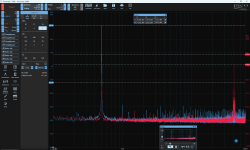One data point I can share is measurements of an n-Core Hypex amplifier driving my diy step-up transformers. For all intense-and purposes, the ~400kHz switching residual bypasses the step-up of the transformer via capacitive coupling between the windings. So, you gain signal-to-noise ratio equivalent to the step-up ratio of the transformer. Worst case, the residual will be of the same magnitude as it was feeding the primary. Btw, have to be careful averaging measurements as the switching frequency does dither about a bit so can give a falsely low reading.And that thus is my basic question: would there any class D switching residue at the secondary of the step-up transformers?
Measurement example shows a switching residual about -9.6dB down from +1.7dB(1.2Vrms) 5kHz signal feeding the primary of a ~70:1 ratio transformer, the output is +38dB @ 5kHz with residual of -12dB…a couple dB below the worst case possible.

At HF well above the passband of the transformer, the residual is essentially feeding a capacitive voltage divider.
So the higher the capacitive load, the lower the residual; worst case being no load at all.
Your Quad transformers have a ratio ~122:1, so I would expect the audio signals you are trying to measure will gain at least 42dB headroom relative to the switching residual when measuring on the secondary side of the transformer.